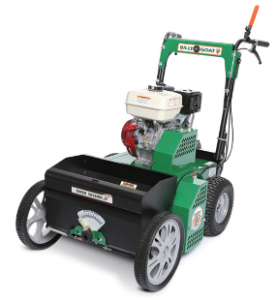Overseeding is popular in landscaping because it keeps turf covered in young grass, giving it a thicker, more lush look than lawns with mature plants. However, it can also be an effective technique for reducing weeds. These tips will help you maximize grass growth so weeds can’t get a foothold.
Get a Soil Test Before You Fertilize
For your new grass to succeed, you need to make the soil has a good balance of nutrients to promote growth. Getting the right mix will increase grass growth while discouraging weeds that thrive in poor soil.
Overseed Early
If drainage is good, you can overseed in the early spring, letting the grass get a foothold before weeds germinate and turf wear becomes an issue. Keep in mind that severe rains can wash away seeds, and freezes can damage them. If you’re not sure if the weather will hold, you may want to wait.
Read the Instructions
How much seed should you be putting down? Check the instructions on the seed bag. There’s no need to go for the intensive overseeding of a golf course, nor should you go light in areas that already have grass. Getting the right drop rate is easy: your Billy Goat overseeder has instructions on the inner flap of the hopper, and the rate is set using a single dial on the front of the machine.
Minimize Soil Disruption
Your new seed needs to make good contact with the soil to germinate, but getting that contact can help weed seeds reach the soil. Bag lawn clippings the last time you mow to remove any germinating weeds. If you need to dethatch beforehand, let the lawn fully recover before overseeding. Your Billy Goat overseeder will do the rest: it uses a verticutting system, making thin slices that keep anything but the newly dropped grass seed penetrate the soil.
Use the Right Seed for Fast Growth
Bermuda grass is the fastest growing grass seed, but due to different climate and soil conditions across the country, it’s not always the best solution. Choose seed based on how its weather, disease, drought and erosion resistance characteristics match your local climate and conditions. If you need help, contact your local extension office: they’ll know exactly what will work in your area.
Keep Herbicides that Won’t Attack New Grass
Most broadleaf treatments are pre-emergent, and they have no problem working on the seeds you want to grow as well as the ones you don’t. If you don’t have enough time to delay overseeding after applying a herbicide, go for a grass safe chemical like 2, 4-D or Trycopyr.
Use the Right Techniques when Watering
There are two good reasons to water early in the morning:
Plants are designed to absorb water better at this time to take advantage of dew that has collected over the night. As the sun goes up, the grass will seal itself to retain moisture when faced with increasing heat.
Fast evaporation during sunlight hours keeps plants dry once they’ve had their fill of water. This discourages the growth of plant diseases.
Always balance watering with rainfall. If the soil isn’t allowed to dry out completely after watering, the roots will have shallow growth. This is the most common cause of persistent weed problems after mower scalping.
Overseed, Even if Conditions Aren’t Ideal
Aside from getting a lush lawn, overseeding takes over spaces where weeds can grow. While you may encourage broadleaf growth if you wait too long to overseed, there will still be fewer weeds to deal with than if you’d done nothing.
Keep Your Equipment Working at its Best
If you need some parts for your overseeder or want to add seeding capability to your power rake, go to www.billygoatparts.com. As a certified dealer for Billy Goat and their manufacturing partners, we’re able to offer accessories and OEM parts for everything on your equipment. Our site can show you parts lists and factory diagrams for your model, making it easy to get exactly what you need. We ship to both the U.S. and Canada.

